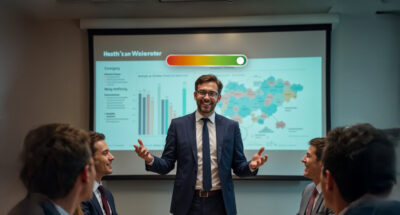
Executive recovery: The backbone of thriving organizations
With executives experiencing unprecedented levels of leadership burnout, here are three ways for organizations to help employees prioritize their recovery...

by Josefine van Zanten Published May 9, 2025 in Talent • 8 min read
When organizations focus on diversity, equity, and inclusion (DE&I), their focus is usually on the numbers of women in management, addressing imbalances of race and ethnicity, or making a more welcoming environment for LGBTQ+ employees. These are all valid choices to address significant and often deeply entrenched inequities.
Yet there is another group of people – a group that constitutes 15-20% of the global population – that has not received the same attention in most DE&I initiatives. Their diversity is invisible, and when recognized, is often categorized as a chronic illness or disability. They are the neurodivergent.
Employers are now beginning to pay more attention to neurodiversity – and rightly so. In a world that new technologies are rapidly reshaping, neurodivergent talent can be both rare and valuable as they bring additional skills and unique analytical capabilities to the table.
So, how can employees better accommodate neurodivergent talent?

Neurodiversity refers to a range of conditions related to brain function, including dyslexia, autism spectrum disorder (ASD), dyspraxia, attention deficit hyperactivity disorder (ADHD), and other conditions. These manifest with distinct levels of severity and, in some cases, may constitute a disability.
While organizations should avoid lumping all neurodivergent conditions together, a historical lack of adequate understanding and subsequently support from employers is a recurring theme. This is both unfair to the affected individuals and a waste of talent. The situation could be avoided if organizations make simple and inexpensive adjustments in the workplace, which will most likely benefit all employees.
Neurodivergent people are often highly talented, with a flair for solving complex problems. As ever, a major part of the rationale for DE&I, backed by scientific research, is that a workforce with different experiences, skills and ways of thinking is more efficient, productive, and better at innovation and problem solving.
Neurodiverse individuals have typically navigated very complex situations in life, so bring rich life experience – as well as offering genuinely different ways of thinking. Fast-growing Dutch chip maker ASML has recognized the potential of neurodivergent employees. The proportion of its employees who are neurodivergent runs well above that of the general population. This in part owes to the initiative of dyslexic former President and CTO, Martin van den Brink. Under him, the company established Atypical, a support network for neurodivergent employees that celebrates their innovative and creative contributions. It has also adapted its HR and working practices to meet the needs of the neurodivergent, in the process positioning and enabling them to contribute more fully to company growth.

“Capturing data on neurodiversity is extremely difficult, not least because in most instances collecting data about neuro-divergent employees can only be based on self-disclosure which, whilst helpful, remains indicative at best.”
Capturing data on neurodiversity is extremely difficult, not least because in most instances collecting data about neuro-divergent employees can only be based on self-disclosure which, whilst helpful, remains indicative at best. In today’s polarized environment, employees will become increasingly reluctant to reveal personal diversity aspects and conditions if they don’t feel completely safe in doing so.
Another key challenge is the varying attitudes and levels of understanding around neurodivergent conditions. Some business cultures are typically more understanding and considerate of neurodivergent needs and behavior than others.
Companies should also capitalize on new digital tools, including AI, to support neurodivergent employees.
Successfully enhancing the working environment for the neurodivergent requires action across several areas.
Update systems and processes: Ensure that organizational processes don’t disadvantage neurodivergent individuals. For example, common recruitment assessment exercises such as word-selection tests can be disproportionately difficult for applicants with certain neurodivergent conditions and lead to their other qualities being overlooked. Similarly, individuals who are highly competent in their roles but struggle with verbal communication may be unfairly disadvantaged in job interviews. Recruiters should explore potential adaptations and ensure that prospective employees are made proactively aware of any support available.
Adjust the workplace: Open-plan offices can be overwhelming for neurodivergent workers. The availability of quiet booths can allow them respite, and small concessions such as allowing people to work with noise-cancelling headphones can make a significant difference. This may mean changing attitudes among managers and colleagues, so that they avoid judging neurodivergent people to be “cutting themselves off” from the team.
Companies should also capitalize on new digital tools, including AI, to support neurodivergent employees. Speech-to-text and text-to-speech software can benefit dyslexic employees, for example, while time management and project tools can benefit those who struggle with executive functioning (setting and achieving goals) and task prioritization, helping them break work into more manageable chunks.
Benchmark best practices: Most companies are on a steep learning curve on neurodiversity and the lack of good workforce data can hold this back. Move up the learning curve faster by sharing and learning from others.
Openness and communication: Company leaders should encourage the adoption of a more positive attitude towards neurodiversity in the workforce, showcasing neurodivergent role models who contribute strongly and thrive in the business, as well as normalizing use of adaptations such as quiet spaces, perhaps by using them themselves. External communication is also key, such as including information about the neurodiversity strategy on the company website, on job descriptions, and discussing it in interviews, so that potential job applicants understand the support that’s available.
Educate managers: As with any aspect of DE&I, businesses should equip their managers to support neurodivergent employees. The CHRO and the DE&I lead will shape initiatives, but other individuals and functions have key roles to play. These include the head of IT around the use of digital technology and the CEO as the highest-profile champion of neurodiversity.

Even as the workplace becomes more accepting of neurodiversity, employers are encountering politically motivated challenges to their DE&I practices. Campaigners against so-called “wokeism” suggest that managers favor minorities unfairly based on gender, sexual orientation, the color of their skin, disability and other differentiating features. This is a deeply distorted and increasingly politicized view of the business case for DE&I – and of the DE&I initiatives to which businesses around the world are committed.
Business leaders understand the necessity of being able to call on a diverse range of viewpoints, life experiences, know-how and networks and that, historically, leadership teams have too often been drawn overwhelmingly from the same demographic group, leading to monocultures.
Major corporations should not and do not hire people on a tokenistic basis. They want the broadest diversity of talents they can get, reflecting the communities they operate in, and mirror their stakeholders and their partners. The importance of DE&I in recruitment and management is to ensure employers do not overlook excellent candidates from various pools of talents and management do not fail to let them reach their utmost potential owing to outdated attitudes and practices.
As senior leaders well know, DE&I is – as much as anything else – about empowering talent so they can perform to their full potential. Abandon DE&I and executives jeopardize future business performance.
Neurodivergent individuals could also use more help and encouragement in full-time education.
IMD’s Anna Dunand, as a mother of a son who is dyslexic and has attention deficit disorder (ADD), has experience of this at both professional and personal levels.
In many regards, Dunand’s son’s is a typical Swiss 15-year-old who enjoys skiing, mountain biking and computer games. But the challenges he has faced in education reflect those that many neurodivergent adults face at work, particularly around planning and time management. “When he looked at his agenda for the week, he used to panic as there was too much going on,” Dunand explains. “We realized that focusing on smaller chunks, like Monday and Tuesday first, reduced his anxiety, allowing him to focus and progress.”
Dunand’s son’s ADD means that noisy environments also present challenges. “He can be in the classroom and pick up every conversation that’s happening at once, which is overwhelming. His mind wanders, so he needs lots of peace and quiet,” she explains.
While she sees businesses making highly effective efforts to encourage neurodiversity, school policies that undermine official claims to support neurodivergent students – for example, effectively denying her son access to use of a laptop to mitigate the effects of his dyslexia – have frustrated Dunand. “Teachers need to help neurodivergent children reach their full potential – which means using all the tools available,” she emphasizes.
Dunand recalls that, when her son was eight, teachers assessed him as being at a low attainment level due to his dyslexia, even though his IQ was very high, potentially jeopardizing his chance of progressing to higher education later. The family challenged that assessment. “We said, ‘You’re putting him in a box,’” recalls Dunand. Now, as these efforts have relieved him of this stigma, her son is thriving in his studies, with a good chance of going to university in a few years’ time to study physics and mathematics, his favorite subjects.
Neurodivergent young people need not and should not face a bleak future, Dunand insists. She points out that neurodivergent people who have achieved highly in education are typically resilient and determined, having had to battle through adversity – something employers should recognize. Further, there is growing interest in the potential benefits of “dyslexic thinking.” LinkedIn has added the term as a positive attribute option for profiles, while Made by Dyslexia, a global charity, in partnership with Virgin and the Open University, has launched a University of Dyslexic Thinking . It aims to reframe dyslexic thinking, in the words of Virgin’s co-founder Sir Richard Branson as “not a weakness but a superpower.”
“Dyslexic thinking is interesting from a workforce perspective because dyslexic people are often very good at thinking in three dimensions,” explains Dunand. “They are highly creative and innovative, have excellent personal skills, and can see the big picture and make connections. These are precisely the skills needed in a world reshaped by AI.”

Global HR Executive
Josefine has been active as an international HR Executive for most of her career, working in Fortune 500 organizations. As a Senior Vice President, she was in charge of departments of D&I, culture change, and leadership and organizational development. Her experience spans various industries including HP (IT), Royal Dutch Shell (Oil and Gas), Royal DSM (Life Sciences and Chemicals), and Holcim (Construction). Until early 2024, she served as the Chief Diversity, Equity & Inclusion (DE&I) officer at IMD, working as a Senior Advisor, EI&D, with global organizations.

June 4, 2025 • by Nele Dael in CHRO Circle
With executives experiencing unprecedented levels of leadership burnout, here are three ways for organizations to help employees prioritize their recovery...

May 30, 2025 in CHRO Circle
Natalia Wallenberg of Ahold Delhaize describes how one of the largest retailers in Europe is tackling the upskilling dilemma....

April 28, 2025 in CHRO Circle
As global trade tensions and US tariffs disrupt conventional supply chains, corporate leaders must reconsider resilience through strategic diversification, regionalization, and risk management in order to remain competitive in an increasingly protectionist...

April 25, 2025 • by Richard Roi in CHRO Circle
Progressing internal talent helps hedge against new CEO failure, but it all hinges on integrating leadership development and succession planning. Ric Roi explains why and shares four strategic steps to getting it...
Explore first person business intelligence from top minds curated for a global executive audience